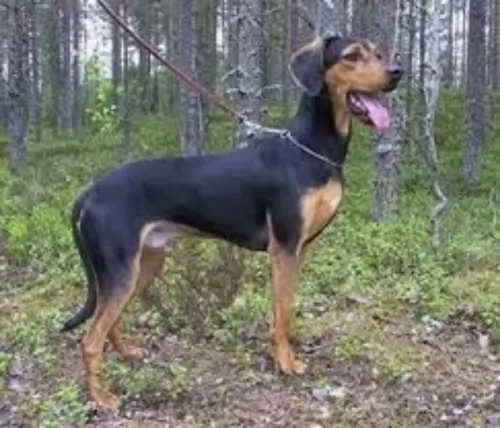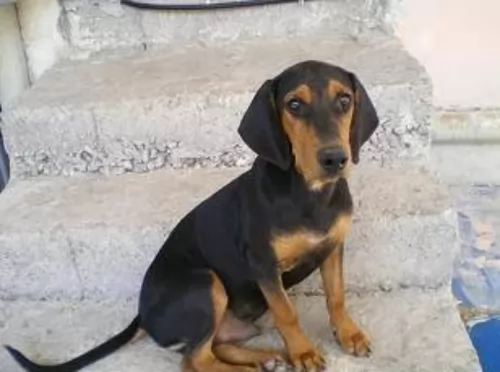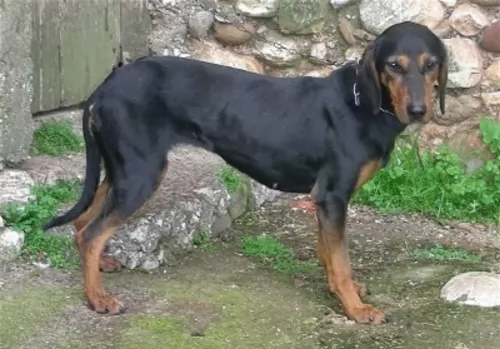 Petzlover
Petzlover Greek Harehound is originated from Greece but Pyredoodle is originated from United States. Greek Harehound may grow 31 cm / 12 inches shorter than Pyredoodle. Greek Harehound may weigh 26 kg / 57 pounds lesser than Pyredoodle. Both Greek Harehound and Pyredoodle has same life span. Greek Harehound may have more litter size than Pyredoodle. Greek Harehound requires Low Maintenance. But Pyredoodle requires Moderate Maintenance
Greek Harehound is originated from Greece but Pyredoodle is originated from United States. Greek Harehound may grow 31 cm / 12 inches shorter than Pyredoodle. Greek Harehound may weigh 26 kg / 57 pounds lesser than Pyredoodle. Both Greek Harehound and Pyredoodle has same life span. Greek Harehound may have more litter size than Pyredoodle. Greek Harehound requires Low Maintenance. But Pyredoodle requires Moderate Maintenance
 Known also as the Hellenic Hound, the Greek Harehound is an ancient breed, and it is a dog which has come down through the ages with very little change to the way he looks.
Known also as the Hellenic Hound, the Greek Harehound is an ancient breed, and it is a dog which has come down through the ages with very little change to the way he looks.
The ancestors of the Greek Harehound go back thousands of years and are believed to be the ancient ‘Laconikoi’ dogs of the Peloponnese.
In was in 1996 that the Federation Cynologique Internationale recognized the Hellenic Hound. The Greek Harehound was also recognized by the United Kennel Club (UKC) in 2006.
 These dogs only originated in the 1980s, and as a designer dog they are a cross between a Standard Poodle and the Great Pyrenees, both ancient dog breeds.
These dogs only originated in the 1980s, and as a designer dog they are a cross between a Standard Poodle and the Great Pyrenees, both ancient dog breeds.
The breeders were looking for a non-shedding variation of both these popular breeds. This dog isn’t part of the American Kennel Club’s (AKC) list of dogs.
 These dogs have a short, dense coat which is black and tan in color. He is a medium sized, well proportioned, deep chested dog standing at roughly 47 – 55cm in height and weighing between 17–20kg.
These dogs have a short, dense coat which is black and tan in color. He is a medium sized, well proportioned, deep chested dog standing at roughly 47 – 55cm in height and weighing between 17–20kg.
His legs are straight, well boned and strong. The skull of the dog is fairly flat, the eyes are brown while the ears are set high and are floppy. The tail is long, tapering down to a tip.
Lively and outgoing, the Greek Harehound is a skilled, brave hunter. These are active dogs and will require quite a bit of exercise if you get one as a pet. He becomes devoted to his owner, making a good, all-round family pet.
He has always been used in the past to hunt in packs so he gets on well with any other dogs in the family.
As a scenthound, the Greek Harehound is an independent, stubborn, strong-willed dog that will respond well to a firm, strong owner. His stubborn, strong-willed nature means it will be important to have him trained and socialized so that he becomes a well-rounded, obedient pet.
If you're looking for a true around-the-house family pet, this isn't the ideal choice as he is essentially a hunting dog, wanting to be running off on a hunt as opposed to lying quietly indoors. He is therefore better suited to life in the country than being cooped up in a small city property.
 The Pyredoodle is a large dog standing at between 60 and 86cm in height and weighing about 38 to 46kg.
The Pyredoodle is a large dog standing at between 60 and 86cm in height and weighing about 38 to 46kg.
The coat varies quite a bit, depending on which breed the dog leans towards. Colors can be white, cream, apricot, silver or black. Essentially the coat is a thick double-coat of medium length hair which is fairly straight or wavy.
The dog is a low shedder, thought to have a hypoallergenic coat. Floppy ears mean you will need to check inside the ears for redness and infection brought on by an excess wax build-up, dirt and moisture. If you allow your Pyredoodle to become a parent, the can produce between 2 to 4 puppies.
Coming from dogs with good temperaments, the Pyredoodle comes as being good natured. He plays well with children and gets on well with other animals in the house.
He is protective and takes his role as watchdog seriously. You can be sure he is going to be a loyal family dog. His high intelligence means he can be trained and socialized with ease and then he becomes obedient and well mannered.
He is good with children, and even though he is looked upon as being sweet natured, he still makes a great watchdog and protector of his human family.
 Fast, courageous, smart, playful, independent and strong willed, the Greek Harehound is a slow maturing breed and he will require training and socialization to make him obedient and not so stubborn.
Fast, courageous, smart, playful, independent and strong willed, the Greek Harehound is a slow maturing breed and he will require training and socialization to make him obedient and not so stubborn.
Once trained he becomes a truly wonderful companion, being affectionate, loyal and outgoing. He makes a good friend of children too.
He is friendly and non-aggressive, though he still makes a good watchdog. He is a low maintenance pet too, and even though he is essentially a hunting dog, he can make anyone a splendid pet.
 Attractive to look at, independent in nature, the Pyredoodle also has watchdog characteristics, being a protector of his human family.
Attractive to look at, independent in nature, the Pyredoodle also has watchdog characteristics, being a protector of his human family.
Like any dog, and particularly big dogs, it is important to train the Pyredoodle otherwise he could be too active and unruly when he comes indoors.
The Pyredoodle will absolutely thrive in a loving home where the people enjoy an active lifestyle.
The Pyredoodle comes from too excellent dog breeds. Both breeds make excellent watch dogs, they’re intelligent dogs who can be easily be trained. You can expect your crossbreed dog to be a loving, loyal, devoted pet who will add a wonderful dimension to your household.
 The Greek Harehound is a healthy dog breed with no particular genetic defects. But like other dogs with floppy ears, they are more prone to infections and the insides of the ears will need to be cleaned frequently. Always do this with the utmost care to avoid damaging your pet's ears.
The Greek Harehound is a healthy dog breed with no particular genetic defects. But like other dogs with floppy ears, they are more prone to infections and the insides of the ears will need to be cleaned frequently. Always do this with the utmost care to avoid damaging your pet's ears.
He is a deep chested dog and this puts him at risk of gastric dilation and volvulus which is commonly referred to as bloat. Its a life threatening health issue where the stomach can twist. The stomach is sealed off as a result and gas builds up. The dog can go into organ failure.
 Designer dogs are often bred with the idea to eliminate some of the typical, common health issues that plague most dogs. These are among others, bloat, cancer, hip dysplasia, skin issues, ear infections, obesity, dental disease and others.
Designer dogs are often bred with the idea to eliminate some of the typical, common health issues that plague most dogs. These are among others, bloat, cancer, hip dysplasia, skin issues, ear infections, obesity, dental disease and others.
It is highly unlikely that your lively Pyredoodle will succumb to any of the major dog illnesses, but you need to watch him and get him to the vet when you see him displaying unnatural symptoms.
It is beneficial for your pet's health to have it neutered or spayed if you aren't interested in the dog having puppies.
 The Greek Harehound is happiest when he senses he is free to follow scents and run. This is why this particular dog breed isn’t suited for life in the city where he has a small garden. He requires large pieces of ground to run free. If you own one of these dogs, he should be taken on daily walks and be involved in lots of sporting activities and games. If you’re a jogger or cyclist, this dog will be thrilled to join you.
The Greek Harehound is happiest when he senses he is free to follow scents and run. This is why this particular dog breed isn’t suited for life in the city where he has a small garden. He requires large pieces of ground to run free. If you own one of these dogs, he should be taken on daily walks and be involved in lots of sporting activities and games. If you’re a jogger or cyclist, this dog will be thrilled to join you.
Dog owners love that this dog is a low maintenance breed. The short coat simply requires a brush twice a week to rid him of loose hairs and to also keep his coat shiny and healthy.
Every new puppy will require a series of vaccinations in his first year to make sure he doesn't develop some of the serious dog diseases there are such as distemper, parvo-virus and rabies among others.
Dogs are carnivores and without human interference have always eaten fresh meat in the wilds. For convenience many people feed their dogs commercially manufactured food.
There are some excellent brands. Choose the best one for your pet and mix in raw meat from time to time as well as cooked rice, chicken and vegetables.
Never leave your pet without a constant supply of fresh, cool water.
 The Pyredoodle is a large dog who will need regular exercise. Apart from walks every day, he’ll need ball- and rope games, throwing the frisbee, hide and seek games as well as games and toys that keep him mentally active as well.
The Pyredoodle is a large dog who will need regular exercise. Apart from walks every day, he’ll need ball- and rope games, throwing the frisbee, hide and seek games as well as games and toys that keep him mentally active as well.
With the Pyredoodle, never try to skimp on his food and buy the cheapest there is. He’ll get sick often because of the unwholesome ingredients such as colorants, preservatives, fillers and very few vitamins and minerals.
If you choose one of the commercially manufactured dog foods, make sure it is the high quality ones. Give him a treat now and again by providing him with tasty home-cooked food. It doesn’t have to be every day, just once or twice a week.
An excellent choice of food is boiled chicken, brown rice or pasta, sweet potatoes, carrots and spinach, all chopped up and added to the dry kibble. When you can, try and include a little bit of raw meat too. Make sure he has constant access to fresh, cool water.
The Pyredoodle can have a coat which can be either short and thick or it can be longer, wavy or quite curly. Grooming will be aimed at removing any loose hairs the dog has by brushing twice a week. The dog is a low shedder.
His floppy ears may mean you needing to check the insides to ensure they are free from infection. Other grooming for this dog includes trimming the nails, checking his eyes and looking inside his mouth for rotting teeth. A bad tooth can be terribly painful for your pet but it can also cause problems with other body parts such as the heart and kidneys.
Get your pet immediately to the vet if you suspect anything that can be detrimental to your dog’s health.